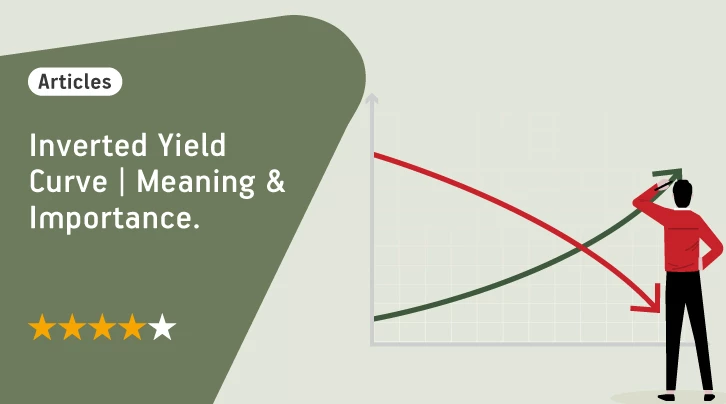The inverted yield curve is commonly considered a sign of a struggling economy. Read this post to understand the inverted yield curve in detail.
A well-developed bond or debt market significantly contributes to the financial growth and stability of the country. Owing to the vital role of the bond market, the yield curve is constantly tracked by investors to gain insights into the country’s overall economy.
This yield curve could be normal (upward-sloping), flat, or inverted (downward-sloping). Let's discuss what is inverted yield curve and how it is interpreted by investors.
What is Yield Curve?
A yield curve is a chart depicting bond yields (returns) of different maturities, with the X-axis plotting the maturity term and the Y-axis showing interest rates. The slope of this curve is used for predicting the interest rate changes and the overall economic health.
For instance, the normal or upward-sloping curve suggests stable economic cycles and conditions. An inverted or downward-sloping curve, on the other hand, suggests an economic slowdown.
What is an Inverted Yield Curve?
An inverted yield curve is a yield curve where short-term yields rise faster than longer-term yields. An inverted yield curve is a phenomenon where you earn less on instruments that you plan to hold for a longer duration.
As mentioned above, a downward-sloping graph depicts a yield curve inversion which is generally considered a sign of economic slowdown or even recession.
Technically, it means the interest rate of short-term bonds exceeds long-term bond rates. This curve is created when investors seek safer investments and prefer bonds with longer maturities over shorter ones.
As the demand for long-term bonds rises, their prices increase, and yields fall as they're inversely related. In this case, selling short-term bonds also reduces their price and increases their yield.
How Should Investors Interpret the Inverted Yield Curve?
Being one of the largest economies in the world, the overall economy of the US is closely tracked by global investors. In the last few decades, the yield inversion of the 10-year vs 2-year US Government bonds has almost always resulted in a recession within 24 months from when the curve inverted.
It has been able to predict even unforeseen downturns, including the dot-com bubble (2001) and the Great Recession (2007). However, there have been false signals too. For instance, the curve inverted around the mid-1960s but only resulted in an economic slowdown and not a full-fledged recession.
Ref - https://www.frbsf.org/economic-research/publications/economic-letter/2018/march/economic-forecasts-with-yield-curve/
https://www.businesstoday.in/markets/global-markets/story/explainer-us-yield-curve-hits-deepest-inversion-since-1981-what-is-it-telling-us-388068-2023-07-04
How to Invest If the Yield Curve Inverts?
Here are a few tips for adjusting your investments if the yield curve inverts-
Avoid Panicking
A yield inversion doesn’t mean you should sell or redeem all your investments. As mentioned above, the curve inversion doesn’t always lead to a recession. In fact, as others will start dumping their investments, it could be a good buying opportunity.
Avoid Risky Industrial Sectors
If the yield curve inverts, you should be careful with the industrial sectors you choose for your investment. For instance, some sectors are directly linked to the yield curves, and the stocks can be very volatile if the curve inverts. Prefer investing in sectors that are not dependent on interest rates.
Invest in a Mix of Assets/Instruments
Diversification is key to minimising investment risks when the yield curve inverts. You can consider a mix of equity and bonds debt to ensure you're not overexposed to a particular market. Carefully chosen mutual fund schemes can also be a good addition to the portfolio.
Consult with an Investment Advisor
If you're new to the world of investments, navigating this period on your own could be challenging. Thus, it'd help if you consult with a professional investment advisor who can help you invest according to your objectives and risk appetite based on the current economic climate.
Analyse the Economy with an Inverted Yield Curve
While an inverted yield curve doesn’t always lead to a recession, a strong correlation exists between economic slowdowns and yield inversions. Thus, investors should keep an eye out for the yield curve to make the right investment decisions.
If you’re struggling with investment choices, the knowledge and experience of a professional investment advisor can help.
Mutual Fund investments are subject to market risks, read all scheme related documents carefully.





 1800-270-7000
1800-270-7000




